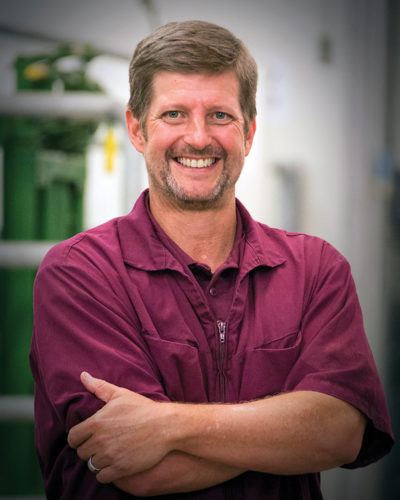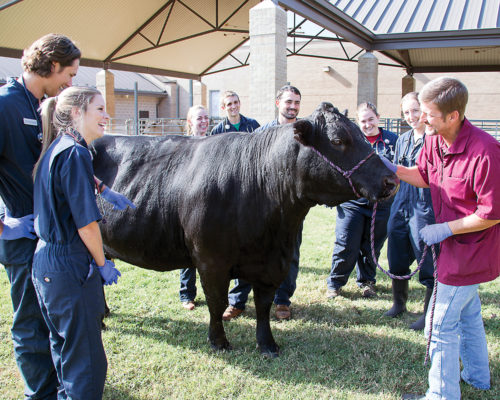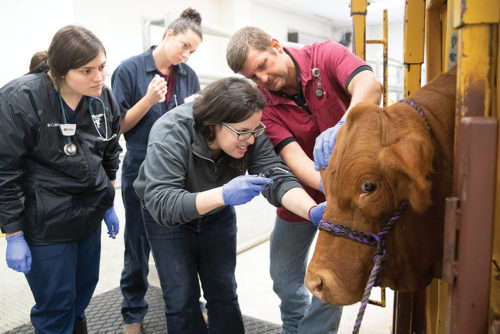Teacher‚ Scientist‚ and Food-Animal Veterinarian — The Many Sides of Kevin Washburn
Story by Vandana Suresh
Dr. Kevin Washburn, a professor in the Texas A&M College of Veterinary Medicine & Biomedical Sciences’ (CVM) Department of Large Animal Clinical Sciences (VLCS), wears many hats.

As a specialist in large animal internal medicine and surgery, he serves the needs of his ailing veterinary patients; as a faculty member, he mentors veterinary students and performs research.
Washburn said the opportunity to practice veterinary medicine alongside teaching and research is precisely what drew him to Texas A&M University 13 years ago.
But his path into veterinary medicine, particularly food-animal medicine, was far from serendipitous. Raised in a rural farming community in southern Oklahoma, he developed a close understanding of animal agriculture.
“I was heavily involved with National Future Farmers of America Organization in high school,” he said. “I exhibited livestock all four years of high school.”
Taking care of his family’s livestock involved frequent trips to the local veterinary clinic.
“The local veterinarian was my neighbor, and I spent quite a bit of time with him when he was working with my cattle,” Washburn said.
Over time, this inside look into a rural veterinary practice solidified Washburn’s interest in pursuing a career in food-animal medicine.
After obtaining a bachelor’s degree in agricultural economics from Oklahoma State University, Washburn joined the Doctor of Veterinary Medicine program there. Although the program did not have a food-animal medicine track, he chose elective courses with an emphasis on food animals. After graduating, he went straight into food-animal private practice.
Although Washburn greatly enjoyed his line of work, he developed a yearning to teach, and he quickly realized that a basic veterinary degree would not suffice for this purpose.
“I knew that to teach I needed to go back to school and become a specialist,” he said. “So, I left my private practice, went back to Oklahoma State University, and completed a residency in large animal internal medicine.”
During his residency, Washburn became board certified in food-animal practice and large animal internal medicine to poise himself for a career in academia.
Then, when a faculty position opened at the veterinary school at Texas A&M, Washburn applied and landed the job. Although taking the job meant moving out of his home state, he was excited by the prospect of a more fulfilling career involving teaching, research, and surgery.
TRAINING FUTURE FOOD-ANIMAL VETERINARIANS
In 2005, when Washburn started teaching at Texas A&M, food-animal medicine was not a career path offered to veterinary students; three years ago, however, that changed when the CVM started the food-animal medicine track.
Washburn now trains students interested in careers in food-animal medicine—an area of veterinary medicine that he is deeply passionate about.

“I really look forward to coming to work every day because of the interaction with students,” he said enthusiastically. “I’m definitely not the wise old owl, but because I worked in private practice for a while before coming back to academia, I can teach my students skills that are highly translatable to private practice, especially in food-animal type practices, because that’s my background.”
When Washburn is asked about his students, his eyes well up with pride.
“We have 16 veterinarians out there in the workforce who have gone through the food-animal track,” he said. “We’ve got at least 11 more who will graduate next May.”
Washburn noted that food-animal clinicians trained in the CVM are a huge benefit for states like Texas where there is a thriving livestock industry.
“I think my job, as a clinical instructor, is to be able to do all that I can to produce veterinarians who can go and serve people in portions of the state, like the Texas Panhandle, that have a predominant livestock industry,” he said. “Our program provides a pipeline for students who want to be feedlot consultant veterinarians, dairy veterinarians, or swine veterinarians in large, production-based facilities.”
TURNING THE SPOTLIGHT ON BOVINE RESEARCH
Washburn also devotes time to research projects that impact the cattle industry, collaborating with partners in academia and industry to develop technology for detecting early signs of bovine respiratory disease (BRD), which is responsible for more than 45 percent of cattle deaths in feedlots.
In one of those collaborative projects, Washburn is investigating whether consuming live yeast can prevent or reduce the severity of the BRD.

Ranchers have been supplementing cattle feed with live yeast for years to boost digestion; however, the role of live yeast in mitigating BRD had not been evaluated. Washburn explained that if active yeast is indeed immunoprotective, adding it to cattle feed in feedlots could be hugely beneficial.
“Since feedlots are where cattle efficiency is most important, that’s when the addition of yeast could potentially oil the immune machinery, so to speak,” Washburn said.
More recently, nonclinical bovine research has also caught Washburn’s interest. He is currently working on a collaborative project related to fetal programming—a term used to describe engineering maternal and paternal genetics to produce genetically desirable traits in the offspring.
In cattle, fetal programming can be used to select for traits such as rapid growth, high weaning weight, and lean muscle in calves.
“It takes fewer generations to get what you want,” Washburn said, implying that fetal programming is faster and much more efficient than traditional crossbreeding methods.
Washburn’s success as an instructor and researcher is reflected in the multiple awards he has won over the years in recognition of his contribution to food-animal medicine—his office is replete with award plaques, medals, and some informal tokens of appreciation, such as a card from a former veterinary student that dons a colorful hand-drawn cow, with “Moo-chas gracias” written on it.
More than the accolades, what really excites him is training future food-animal veterinarians, forging new collaborations, and pursuing novel research directions.
“I’m very glad that I came to Texas A&M on a tire-kicking mission and decided, oh my goodness, this is awesome,” he said.
###
Note: This story originally appeared in the 2019 Spring edition of CVM Today.
For more information about the Texas A&M College of Veterinary Medicine & Biomedical Sciences, please visit our website at vetmed.tamu.edu or join us on Facebook, Instagram, and Twitter.
Contact Information: Jennifer Gauntt, Interim Director of Communications, Media & Public Relations, Texas A&M College of Veterinary Medicine & Biomedical Science; jgauntt@cvm.tamu.edu; 979-862-4216


